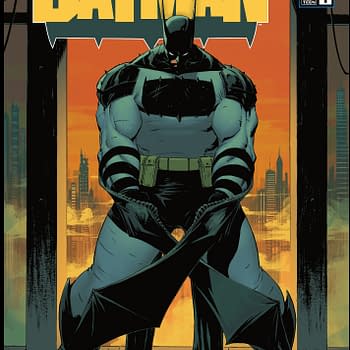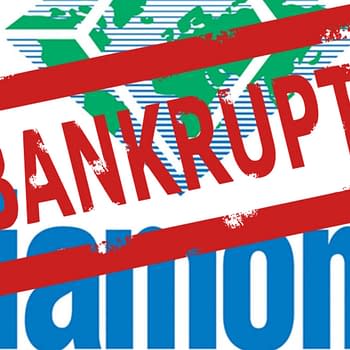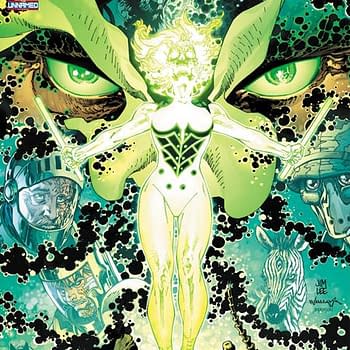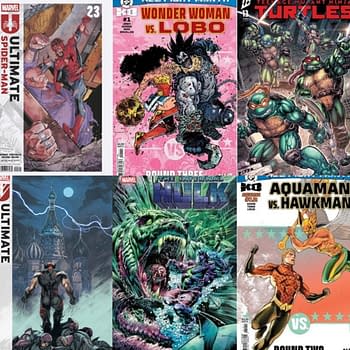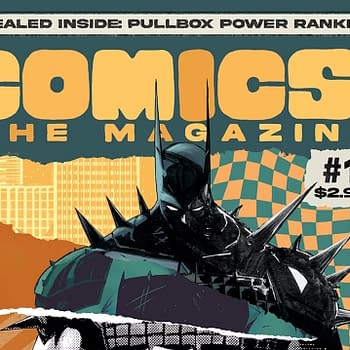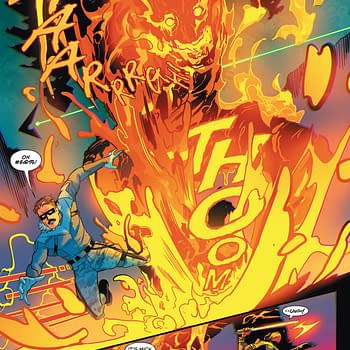Posted in: Comics | Tagged: Alan Moore, brian bolland, Comics, dc, grant morrison, julian darius, kevin smith, killing joke
So How Did The Joker Die In The Killing Joke? And The Script Of The Final Page
That's Julian Darius from his book And the Universe so Big: Understanding Batman: The Killing Joke. Available on the Kindle here in the UK and here in the USA.
Yesterday we ran Grant Morrison's rather convincing theory that Batman kills The Joker at the end of The Killing Joke by Alan Moore and Brian Bolland by breaking his neck. And the surprise that this hadn't come up before. But clearly, from this book published last November, it had – and in quite detailed depth.
But Julian looks at one of the Joker's own poisoned needles as the murder weapon rather than Batman's bare hands. He looks at the motivation, the repeated symbolism and more. But I'm quoting here some of the physical realities he highlights. Such as the beams of light and some of the odd aspects of the previous fight scene . He writes;
"Next comes another ambiguous sequence with potentially profound implications for the story. In the foreground, we see the Joker's right hand as a knife slips down from his sleeve and into his palm. As Batman is recovering, the Joker tries to stab him in the back. Batman uses his left hand to grab the Joker's right wrist, then punches the Joker, in what looks like the abdomen, with his right hand.
This is a crucial sequence because, while readers would be forgiven for not noticing it, the Batman stares at his right hand while recovering. It's very strange, and can easily go under the reader's radar, particularly since comics fans are accustomed to breezing through such otherwise typical fight scenes.
Something's clearly going on there. Did he find one of the Joker's poisoned needles along the wooden beam that he fell against? When Batman kicks it out of the Joker's hand on the previous page, it's not clear exactly what position the Joker was in or where the device went, but it was shown heading upwards in response to the kick. Could it have arced high enough to hit the wall and come to rest along that wooden railing? Did it, perhaps, get stuck in his glove as a woozy Batman used his right hand to lift himself up? Is he pulling it out of the glove with his left hand in that ambiguous panel in which he has both hands in front of his face, just before he reaches back to catch the Joker's wrist with his left hand? Is Batman inspecting the puncture in that panel, making sure that the needle only got caught in the armored glove but didn't reach flesh? We know, from the use of the needle on the amusement park owner, that it couldn't have punctured Batman's skin, since that earlier victim died almost instantly and without uttering a word. But does the awareness of how close he just came to death spur an already angry and injured Batman to the sudden rage that he seems to have in that scene?
Why isn't the Joker shown dying? Well, he kind of is. We've already seen how quickly the Joker's toxin works – it killed the amusement park owner immediately and without a sound, yet it didn't cause him to slump and fall off the little elephant ride that he was on. After Batman stabs him, the Joker's laughter continues for a single panel. Then it abruptly stops, as if the Joker's suddenly gone silent. We may merely think that the comic has essentially muted the audio – stopped giving us sound effects. But the police siren continues for another panel, as if suggesting that the Joker really has abruptly stopped laughing. Maybe he did, but that wouldn't be very much in character.
The Joker needn't slump over into the water below because, as we've already seen, his toxin seems to paralyze the body. The amusement park owner didn't slump off his elephant ride – he simply froze in place. We've already been shown what the toxin does to its victims, and this is entirely consistent with what we're shown of the Joker's response here. Arguably, his response is more consistant with becoming a victim of the toxin than not."
He's right, it is an odd page. I remember for some reason thinking Batman has a glove mirror or something similar, But I'm getting convinced… and then we get to that final page. And yes, it's the sudden stop and the previously seen nature of the toxin that gets me here. Julian paints a very convincing case. And then goes further… but I'll leave it to those who buy the book.
And yes, it's ambiguous and that's the point. But not just from a narrative point, Julian looks at the nature of the publishing world at the time.
But there's another twist, because the actual script of The Killing Joke doesn't even hint at his death, when Alan Moore describes the story to Brian Bolland. Could this have been a way to avoid the eyes of DC editors who might have seen the script, while the real nature of the script was shared by phone call? Or did Moore not even let Bolland in on what he was planning?
I mean there's a hint. Batman is going to kill the Joker one day. Is it this day?
As we were going to run this article, Darius got in touch to send us his video response by Grant Morrison's piece, including the poisoned needle theory, which you'll be seeing here for the first time.
[youtube]http://www.youtube.com/watch?v=6iofFLKsU4o[/youtube]
I'm convinced. Though I am hoping to hear from Brian Bolland. And, you know, at some point in an interview, someone's going to ask Alan Moore.
But remember, I also found this theory just as convincing. Until Dave Gibbons cruelly dashed it…
So, in the spirit of that I've made my decision. I think Batman and Joker are kissing. And the story should be renamed The Kissing Joke.
Job done.












